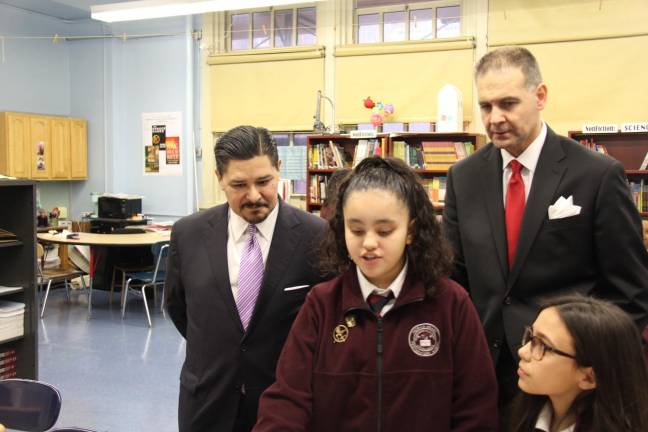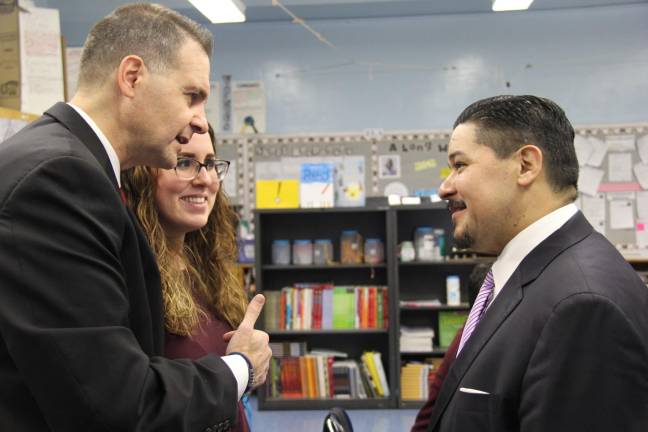“I am always reflecting on how we can do better”
The principal of a nationally-honored public school in East Harlem on how to transform students’ lives through education


By Ema Schumer
PS/IS 171, also called Patrick Henry Prep, is a pre-Kindergarten to Grade 8 public school located in East Harlem with a student population of 772. Like other public schools throughout the city, the school serves a racially diverse group of students: 57 percent of its students are Hispanic, 27 percent are African-American, 9 percent are Asian, 4 percent are Caucasian, 2 percent are multiracial, and 1 percent are American Indian. Like other public schools, enrollment is based primarily on geographic proximity.
Unlike any other New York City public school, however, PS/IS 171 was one of only four schools throughout the nation to receive the distinction of America’s Best Urban Schools Gold Winner. The accolade is given by the National Center for Urban School Transformation (NCUST) at San Diego State University (SDSU). “The winning schools have attained a level of achievement more typically seen in schools that serve very affluent communities,” NCUST Executive Director Joseph F. Johnson Jr. said in a press release. “In these impressive schools, outstanding teachers and leaders maintain very high expectations for all of their students ... These schools exemplify how otherwise typical urban schools can transform students’ lives.”
At the helm of this nationally-recognized school is Principal Dimitres Pantelidis, who has spent nearly thirty years working in public education in various teaching and administrative roles all within East Harlem. Pantelidis reflected on his school’s achievement and offered insight into what has enabled PS/IS 171 to attain such success in an emailed-Q&A with Our Town.
How would you describe PS/IS 171's teaching philosophy?
We believe that if we structure our classrooms as a learner-centered environment, all students will succeed. Students will be taught explicit strategies that can be transferred across skills. Through a thematic approach to instruction, content areas will no longer be taught in isolation. Curricula across K-8 will be both standards-aligned and reflective of students’ identities, experiences, and interests. Our vision [is] to provide all P.S. 171 students access to becoming lifelong independent learners.
Congratulations on your national recognition. What do you attribute your success to?
Firstly, I cannot emphasize [enough] the importance of collaboration between our staff, teachers, parents and community members and how it has brought us together to make a difference in urban education. I applaud their diligence and professionalism put forth every day to ensure our students have the necessary skills and mindsets to achieve success in their education and future endeavors. This award is a humble reflection of their hard work to integrate our core values of “dedication, open-mindedness, and community” into daily teaching and learning practices.
Secondly, I firmly believe in leading a school that has a clear vision with precise systems and structures in place. Over the years we have refined and strengthened these systems, ingraining them into the foundation of our work. The systems I am referring to are Data Driven Instruction, Professional Learning, and Teacher Teams.
P.S. 171 outlined a uniform cycle of data-driven instruction. Each of the cycle’s stages -- assessment, data organization and analysis, instructional planning and student work analysis -- is described in our handbook. This booklet is a critical resource that supports teachers in bridging instructional theory to data-driven practices.
P.S. 171’s professional learning cycle showcases how overarching learning goals are aligned to school goals and then designed through theories of action. Professional learning syllabi and action plans support teacher-led experiences informed by varying interests, skill sets and/or experience levels.
With our teacher teams, P.S. 171 teachers collaborate in grade-level teams to analyze both qualitative and quantitative data and refine curricula to meet students’ diverse learning interests and needs. Teachers work collaboratively with administration, peers and instructional coaches to construct learning environments that inspire students to exceed.
What are the challenges of teaching children from predominantly low-income backgrounds and how do you overcome these challenges?
One of the biggest challenges we face is with chronic absenteeism. According to the website attendanceworks.org, “Students who live in communities with high levels of poverty are four times more likely to be chronically absent than others often for reasons beyond their control, such as unstable housing, unreliable transportation and a lack of access to health care.”
We know there is a clear alignment between attendance and student achievement. To overcome this obstacle, we needed to peel back the layers and have an honest discussion that would lead to an authentic resolution. The last thing we want is to end up with a “band-aid” plan. We really wanted to invest in a long-term solution that would increase attendance rates and student achievement.
Our plan includes refining our curriculum to increase student engagement and reflect the Chancellor’s initiative of Equity and Access for All. We overhauled our classroom schedules to include sacred time for staff to implement responsive classroom[s]. Teachers are excited to create an environment that builds self-awareness, self-esteem, respect and community, kindling the fire within our students that inspires them to say they are excited to come to school, no matter what the challenge.
And through our Community Reads initiative, we are seeing significantly more parents in the classrooms. Students are excited to work through a text with their family, engaged in deep conversation and often creating fun projects strengthening the home and school partnership.
According to our 2018-2019 school survey results, “97% of families say that they get opportunities to visit their child's classroom, such as observing instruction or participating in an activity with their child.” Staff are dedicating personal time to communicate with parents and bring them in after school hours, offering workshops and family engagement events such as paint night.
Now that you have received this national award, what are your hopes for the future of PS/IS 171?
I love education! I am always reflecting on how we can do better. Academic excellence is guided by the school vision and our belief that, through distinguished teaching that recognizes individual learning needs and effective application of technology resources, we can best prepare our students to successfully meet the challenges of high school, college and career.
I took an important journey with my extraordinary staff. Through self-reflection, diving deeply into the core of the school community, we redefined the values of the school as the needs of the East Harlem community evolve. Together, we refined our rigorous core curriculum. P.S. 171 has successfully established a collaborative school culture that engages our students with a love for learning and a strong sense of optimism for their futures.
This interview has been edited and condensed.